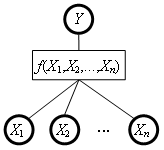Combinatorial Explosion
Consider a utility function f that maps the values of the attributes X1, X2,…, Xn into the value of the aggregate attribute Y.

In DEXi, a utility function maps all the combinations of the lower-level attribute values into the values of Y. Suppose that each Xi has a scale consisting of si values. Then, the number of combinations and thus the size of f is equal to
S = s1 × s2 × … × sn
In other words, when defining f, you should define S decision rules.
Example
Let all the n lower-level attributes have s-valued scales. In this case, the size of f equals to
S =sn
The following table shows how fast S grows with the increasing n and s.

Recommendations
Experience shows that utility functions of size up to 25 are small and usually quite easy to define. The difficulty grows towards the size of about 100, which is already quite difficult. Everything above 100 is very difficult, and everything above 500 is extremely hard if not impossible to define.
Also, it is not only the size that matters. The more the attributes, the more difficult the function to define, even if the size of the functions is comparable. Combining four attributes together usually appears quite a hard task for human brain.
For these reasons, the DEXi method strongly advises to limit the number of aggregate attributes’ descendants to three, and to restructure the tree of attributes whenever this condition has not been met.
To prevent the combinatorial explosion, the DEXi program issues a warning before creating a function of size 200 or more, and disallows the creation of functions larger than 1000.